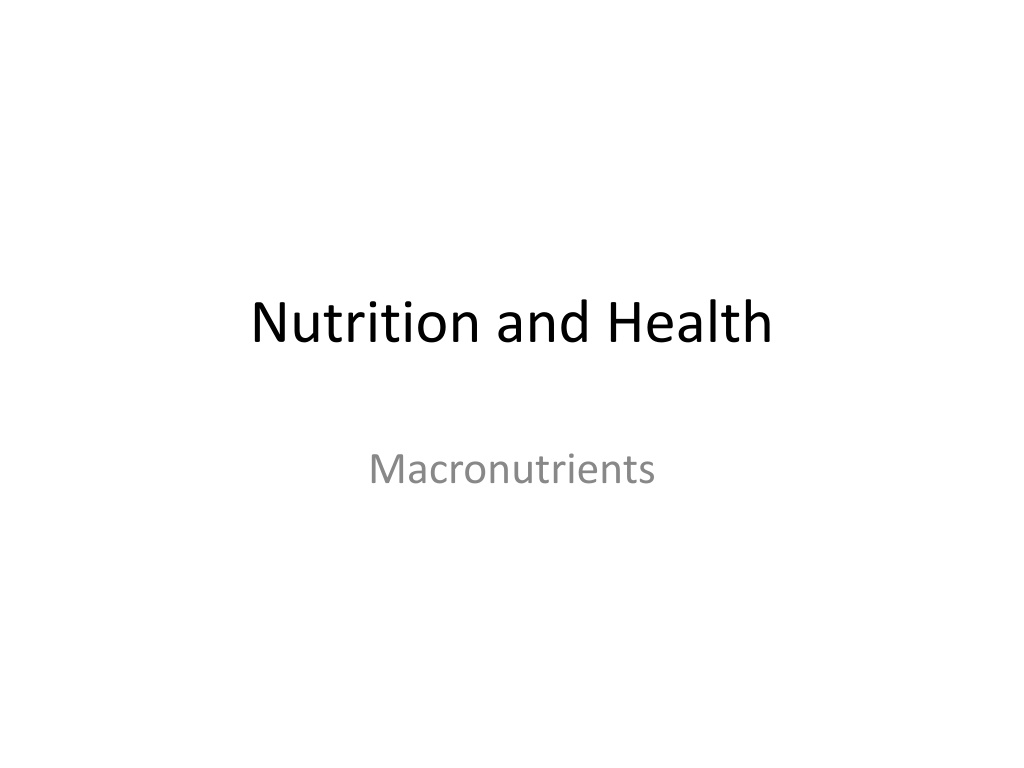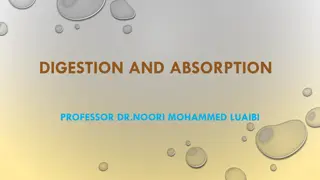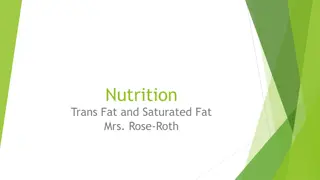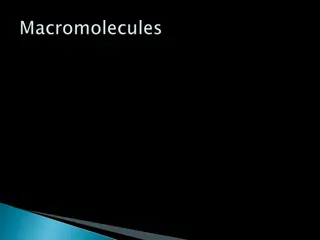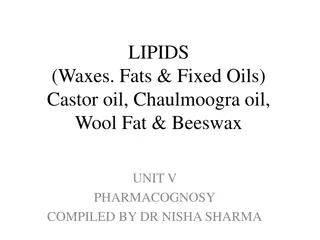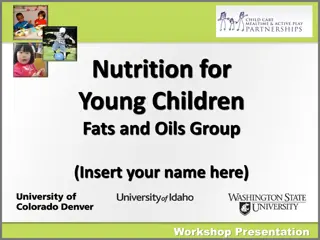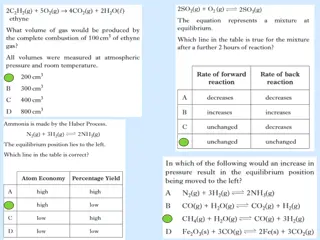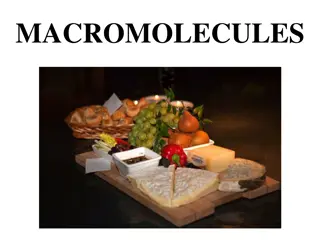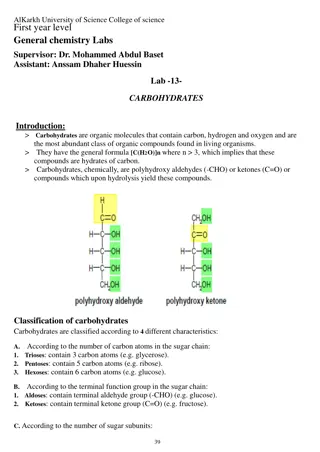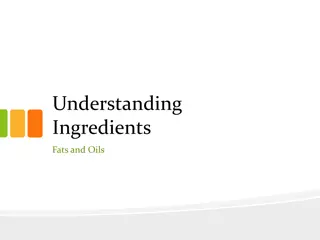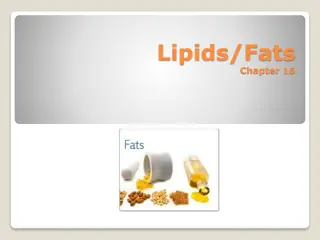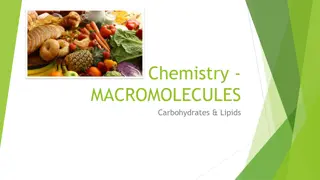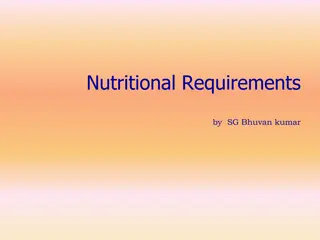Macronutrients: Carbohydrates, Sugar, Proteins, Fats
Explore the essential macronutrients including carbohydrates, sugar, proteins, and fats. Learn about their functions, types, food sources, and impact on health. Understand the role of sugar in energy provision and potential health risks. Discover the importance of starch as a common carbohydrate in our diet.
Download Presentation

Please find below an Image/Link to download the presentation.
The content on the website is provided AS IS for your information and personal use only. It may not be sold, licensed, or shared on other websites without obtaining consent from the author.If you encounter any issues during the download, it is possible that the publisher has removed the file from their server.
You are allowed to download the files provided on this website for personal or commercial use, subject to the condition that they are used lawfully. All files are the property of their respective owners.
The content on the website is provided AS IS for your information and personal use only. It may not be sold, licensed, or shared on other websites without obtaining consent from the author.
E N D
Presentation Transcript
Nutrition and Health Macronutrients
Topics Carbohydrates Sugar Starch Cellulose Proteins Fats and Oils Saturated fatty acids Unsaturated fatty acids Cholesterol 2
Functions of Carbohydrates Carbohydrate is an energy-giving nutrient It provides energy for: keeping the body warm the body organs to work properly, e.g. breathing, digesting daily activities (e.g. sitting, walking) and other physical activities (e.g. swimming, playing ball games) 4
Types of Carbohydrates There are three types of carbohydrates Sugar Starch Cellulose 5
Sugar What is sugar? Sugar is a quick source of energy It is an empty energy food , because it only provides energy with no other nutrients Sugar on food labels may appear as sucrose, glucose / dextrose, fructose, maltose, lactose, corn syrup, honey, and molasses 6
Sugar Sources of sugar Sugar is present in fruits, vegetables and milk The sugar used everyday is mainly processed from sugar cane or sugar beet 7
Sugar Uses of sugar Sugar is often added to processed foods Hidden sugar is a component of processed food that cannot be seen 8
Sugar Sugar is the main cause of tooth decay Excess sugar will be stored inside body as fat, the result can be overweight 9
Starch What is starch? It consists of a large number of glucose units joined together The most common carbohydrate in the human diet Starch is contained in many staple foods Starchy foods are good sources of energy 10
Starch Sources of starch Starch is stored in many plants Foods that are rich in starch: Food Groups Examples Grains Rice, oats, barley, and wheat - Products that are made from these grains such as noodles, pastas, bread, and crackers Fruits Banana (unripe) Vegetables Potatoes, corn Alternatives Legumes Peas, lentils, kidney beans, red beans, and split peas 11
Starch Dietary requirement For an average adult, starch and sugar should form about 50-60% of the daily energy requirement 12
Dietary Requirement Calorie Percentage 50 - 60 Carbohydrate Protein 10 - 20 Fat < 30 13
Dietary Requirement Protein (1 gram provides 4 kcal) Carbohydrate Fat (1 gram provides 9 kcal) (1 gram provides 3.75 kcal) Energy 14
Dietary Requirement Example: Answer: If carbohydrate forms 55% of daily energy requirement, how much carbohydrate should a person eat in one day? Energy originates from carbohydrate: 1,800 kcal x 55% = 990 kcal (Assume the daily energy requirement for this person is 1,800 kcal.) Amount of carbohydrate to be eaten per day: 990 kcal 3.75 kcal/gram = 264 gram 15
Starch Excess starch will be stored inside body as fat, the result can be overweight 16
Cellulose What is cellulose? Cellulose is found in the wall of plant cells It is the main source of dietary fibre Dietary fibre helps to remove body waste It prevents constipation and other intestinal problems 17
Cellulose Cell wall, contains cellulose, hemicellulose, pectic substances, and lignin Plasma membrane Mitochondria Ribosomes Chloroplast Endoplasmic reticulum Vacuole, holds water and provides crispy texture to vegetables and fruits Nucleus Structure of Vegetables / Fruits 18
Cellulose Sources of cellulose Foods that are rich in cellulose: plant food like whole grain wheat, oat, legumes, cabbage, cauliflower, choy sum, berries, apples, etc. Foods that do not contain cellulose: animal food like pork, beef, fish, etc. 19
Cellulose Dietary requirement Reference value of dietary fibre: not less than 25g per day Department of Health promotes 2 plus 3 a day in order to improve health and reduce risks of chronic diseases Source: Centre for Health Protection, Department of Health 20
Cellulose One serving of fruit is approximately defined as: 2 pieces of small-sized fruits (such as plum, kiwifruit) 1 piece of medium-sized fruit (such as orange, apple) piece of large-sized fruit (such as banana, grapefruit, star fruit) bowl of fruit cuts (such as watermelon, cantaloupe, honeydew melon) bowl of mini-sized fruit (such as grapes, lychees, cherries, strawberries) 1 tablespoon of dried fruits without added sugar or salt (such as raisin, pitted prune) cup of pure fruit juice without added sugar (such as fresh orange juice with pulp) Remark: 1 cup = 240 ml 1 bowl = 250-300 ml Source: Centre for Health Protection, Department of Health 21
Cellulose One serving of vegetables is approximately defined as: 1 bowl of raw leafy vegetables (e.g. lettuce, purple cabbage) bowl of cooked vegetables, sprouts, gourds, beans or mushrooms (e.g. Chinese flowering cabbage, Chinese kale, spinach, white cabbage, bean sprouts, eggplant, carrot, snow pea, Enokitake mushroom) cup of fresh vegetable juice* without added sugar (e.g. fresh tomato juice) Remark: 1 cup = 240 ml 1 bowl = 250-300 ml Source: Centre for Food Safety, Department of Health 22
PROTEINS 23
Functions of Proteins For body growth Repair and replace damaged cells Provide energy 24
What is Protein? Proteins are made up of amino acids The human body needs 20 types of amino acids to build all the proteins needed nine of them are essential amino acids, i.e. cannot be made by the body the rest are non-essential amino acids 25
Types of Protein? There are two types of protein: High biological value (HBV) proteins found in most animal proteins contain a good amount of all the essential amino acids Low biological value (LBV) proteins found in most plant proteins does not supply all the essential amino acids 26
Sources of Proteins High biological value proteins Meat Poultry Fish Milk and dairy products Egg Bean curd Soya bean is the only plant food which provides HBV proteins Low biological value proteins Rice Bread Almonds Mung beans Red beans Cashew Green peas Gluten Dried mushrooms 27
Improving the Protein Quality of a Meal When eating proteins from two different plant sources, the amino acids in one food can supplement the amino acids lacking in the other food In eating a plant protein food with an animal protein food, the biological value of the protein mixture in the meal is also improved 28
Improving the Protein Quality of a Meal Examples of supplementing amino acids with two different foods Cereals Milk Toast Taro Baked beans Chicken wings 29
Proteins Inadequate intake of protein affect growth in children, slow down or even stop growing not common in adults, since most foods contain proteins Excessive intake of protein excessive protein will be turned into energy and stored in our body as fat 30
Functions of Fats and Oils Fat stores heat, which can be used as energy when necessary. The layer of fat directly beneath our skin also serves as a kind of insulation, which helps maintain our body temperature. Most fats are found in adipose tissues, which surround and protect our body's internal organs. Fat serves as a medium for transporting and absorbing fat-soluble vitamins such as vitamins A, D, E and K. Fat is an essential ingredient in the production of cholesterol, bile acid, and certain hormones. Fat ensures the proper functioning of our nervous system and our skin. Source: Centre for Health Protection, Department of Health 32
What are Fats and Oils? Fat is a nutrient yielding high amount of energy The amount of energy provided by fat doubles the amount of energy provided by carbohydrates or protein of the same weight People enjoy fats and oils in the diet due to its flavour, mouthfeel, palatability, texture and aroma 33
What are Fats and Oils? Lipids are sometimes used as a synonym for fats Lipids comprise a group of naturally occurring molecules that includes fats, sterols, fat-soluble vitamins, monoglycerides, diglycerides, triglycerides, and phospholipids Two origins: plant and animal Both fats and oils belong to lipids Fat - solid at room temperature Oil - liquid at room temperature They are chemically similar, but differ in physical state 34
Types of Fats and Oils Based on Origin Animal Source Pork fats (bacon, lard) Animal fats (solid at room temp.) Beef/mutton fats (tallow) Poultry fats (chicken fat, duck fat) Dairy fats (butter, ghee) Cod liver oil Marine oils / fish oils (liquid at room temp.) Whale oil Shark liver oil etc. 35
Types of Fats and Oils Based on Origin Cocoa butter Plant Source Fats (solid at room temp.) Coconut oil Palm oil Peanut oil Oils (liquid at room temp.) Sesame oil Sunflower oil Safflower oil Corn oil Cotton seed oil Olive oil 36
Types of Fats and Oils Some fats are visible, some fats are invisible Foods containing visible fats Foods containing invisible fats Cooking oil Butter Margarine Lard Oil floating on soup Salad dressing Potato chips Bakery products Meat sausages Ice-cream 37
Fats and Oils Inadequate intake of fats and oils not common in developed countries can be seen occasionally in developing countries, may hinder absorption of fat soluble vitamins, such as vitamin A, hence causing night blindness Excessive intake of fats and oils excess fat will be stored in our body, and causing overweight and obesity individuals can have higher risk in developing chronic diseases like coronary heart disease, hypercholesterolaemia (high blood cholesterol), etc. 38
Structure and Composition of Fats and Oils Glycerides Glycerides contain a glycerol molecule backbone joined to one or more fatty acid molecules There are monoglycerides, diglycerides, and triglycerides A monoglyceride contains glycerol esterified to one fatty acid molecule Fats and oils are triglycerides, the major constituent of lipids More than 95% of fatty substance in food is triglycerides 39
Structure and Composition of Fats and Oils One fatty acid chain A monoglyceride Glycerol Three fatty acid chains A triglyceride 40
Structure and Composition of Fats and Oils Fatty acids Fatty acids are long hydrocarbon chains with a methyl group (CH3) at one end of the chain and a carboxylic acid group (COOH) at the other Most natural fatty acids contain from 4 to 24 carbon atoms and most contain an even number of carbon atoms in the chain Animal fats typically have 18 carbons in the fatty acid chain These long chains are made of various fatty acids, such as saturated fatty acid, monounsaturated fatty acid and polyunsaturated fatty acid Example of a saturated fatty acid 41
Sources of Fatty Acids Saturated Fatty Acids Monounsaturated Fatty Acids Polyunsaturated Fatty Acids Coconut oil Safflower oil Flaxseed oil Soybean oil Butter Olive oil Palm oil Canola oil Corn oil Sunflower oil Cotton seed oil Lard 42
Sources of Fatty Acids Comparison of composition of dietary fat (Source: Canola Council of Canada) 100% 90% 80% 70% 60% 50% 40% 30% 20% 10% 0% Saturated Fat Polyunsaturated Fat Alpha Linolenic Monounsaturated Fat 43
Saturated Fatty Acids In saturated fatty acids (SFA), there is only single carbon-to-carbon bonds, they have a linear shape Generally, saturated fatty acids are solid at room temperature and have high melting points 44
Saturated Fatty Acids Increase clotting activity in the bloodstream and thus develop arterial thickening, which leads to strokes, heart attack and other forms of damage Stimulate the production of cholesterol by our liver Excessive intake of saturated fats causes an increase in bad cholesterol that impedes blood flow, and causes more damage to health than direct consumption of dietary cholesterol Source: Centre for Health Protection, Department of Health 45
Unsaturated Fatty Acids Fatty acids may also be unsaturated, containing one or more carbon-to-carbon double bonds Monounsaturated fatty acids (MUFA) contain only one double bond, such as oleic acid Polyunsaturated fatty acids (PUFA) contain two or more double bonds, such as linoleic and linolenic acids Generally, unsaturated fatty acids are liquid at room temperature and have low melting points 46
Unsaturated Fatty Acids In polyunsaturated fatty acids, the hydrogen atoms can be arranged in one of two ways. One arrangement is called cis, the other is called trans. In nature, most unsaturated fatty acids are cis fatty acids. Trans fatty acids are produced along with hydrogenated oil. Hydrogenation is the process of adding hydrogen to unsaturated fatty acids to reduce the number of double bonds. Small amounts of trans fatty acids occur naturally in foods like beef, lamb, and dairy products. 47
Unsaturated Fatty Acids Cis and trans configuration The double bonds in fatty acids occur in either cis or the trans configuration H H \ / C = C / \ H H \ / C = C / \ H H Trans - the hydrogen atoms are located on opposite sides of the double bond, across from one another Cis - the hydrogen atoms attached to the carbon atoms of the double bond are located on the same side of the double bond The trans double bond has a higher melting point than the cis configuration The trans configuration does not significantly change the linear shape of the molecule (about 42o bend in cis linear hydrocarbon chain) 48
Sources of Cis Fatty Acids and Trans Fatty Acids Cis Fatty Acids Trans Fatty Acids Flaxseed oil Margarine Soybean oil Shortening Crisps and snacks Corn oil Packaged desserts, cakes, and pastries Cotton seed oil 49
Monounsaturated Fatty Acids Very beneficial to health Help to reduce the level of low-density lipoprotein (also known as bad cholesterol) in the blood stream and prevent blockage of the arteries Source: Centre for Health Protection, Department of Health 50
